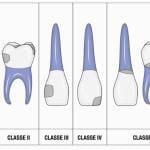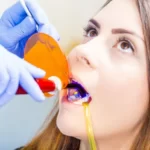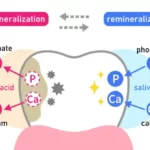Glass ionomer cement (GIC), commonly known as glass ionomer, is a dental restorative material that has gained significant popularity over the years due to its unique properties and wide range of applications. Developed in the late 1960s, glass ionomers revolutionized the field of dentistry by offering a versatile alternative to traditional restorative materials such as amalgam and composite resins. This article provides a comprehensive overview of glass ionomer, including their composition, properties, clinical applications, advantages, limitations, and future prospects.
Composition and Setting Reaction
Glass ionomers are primarily composed of a powdered glass component (fluoroaluminosilicate glass) and a liquid component (polyacrylic acid or a similar acidic polymer). The glass powder consists of various oxides, including alumina, silica, calcium, sodium, and fluoride, among others. The liquid component acts as a binder and facilitates the setting reaction. When the powder and liquid are mixed together, an acid-base reaction occurs, leading to the formation of a hardened material. The setting reaction involves an acid-base neutralization reaction between the carboxyl groups of the liquid component and the calcium and aluminum ions of the glass powder. Water molecules are released during the reaction, contributing to the material’s self-adhesive and self-curing properties.
Properties of Glass Ionomer
- Adhesion
- Biocompatibility
- Fluoride Release
- Thermal Compatibility
- Esthetics
Adhesion
Glass ionomers exhibit excellent adhesive properties, allowing them to bond chemically to tooth structure. This adhesion is attributed to the ionic interaction between the carboxyl groups of the glass ionomer and the calcium ions in hydroxyapatite, forming a strong bond between the material and the tooth.
Biocompatibility
Glass ionomers are biocompatible materials, meaning they are well-tolerated by the oral tissues and do not cause significant adverse reactions.
Fluoride Release
One of the notable characteristics of glass ionomers is their ability to release fluoride ions over an extended period. This property helps in preventing secondary caries formation and promotes remineralization of the tooth structure.
Thermal Compatibility
Glass ionomers have a similar thermal expansion coefficient to natural tooth structure, reducing the risk of marginal leakage and secondary caries formation.
Esthetics
While traditional glass ionomers have limited esthetic properties, newer formulations have been developed with improved translucency and color matching capabilities, allowing for more esthetically pleasing restorations.
Clinical Applications
- Restorative Dentistry
- Luting Agents
- Pit and Fissure Sealants
- Orthodontics
Restorative Dentistry
Glass ionomers are commonly used for Class I, II, and V restorations in non-stress-bearing areas, particularly in pediatric and geriatric patients. They can also be used as liners or bases under composite restorations.
Luting Agents
Glass ionomers are utilized as luting cements for the cementation of metal and ceramic restorations, including crowns, bridges, inlays and onlays. Their adhesive properties and biocompatibility make them an ideal choice for such applications.
Pit and Fissure Sealants
Glass ionomers can be used as pit and fissure sealants to prevent caries formation in susceptible areas of the teeth, such as deep pits and fissures.
Orthodontics
Glass ionomers find utility in orthodontics as they can be used for bonding orthodontic brackets to the teeth due to their adhesive properties and fluoride release.
Advantages of Glass Ionomer
- Biocompatibility
- Fluoride Release
- Adhesion to Tooth Structure
- Minimal Sensitivity
- Moisture Tolerance
- Easy and Fast Placement
- Potential for Chemical Bonding to Metal
Biocompatibility
Glass ionomers have minimal cytotoxicity and are well-tolerated by the oral tissues, making them suitable for various dental applications.
Fluoride Release
The continuous release of fluoride ions helps in preventing secondary caries and enhances the remineralization of the adjacent tooth structure, providing added protection against decay.
Adhesion to Tooth Structure
Glass ionomers form a strong chemical bond with tooth structure, eliminating the need for extensive tooth preparation and reducing the risk of microleakage and recurrent caries.
Minimal Sensitivity
Glass ionomers have low post-operative sensitivity compared to other restorative materials, making them a favorable choice for patients with sensitive teeth.
Moisture Tolerance
Glass ionomers have the unique ability to set and harden in a moist environment, which is advantageous in situations where optimal isolation of the treatment area is challenging, such as in pediatric patients or in patients with excessive saliva flow.
Easy and Fast Placement
Glass ionomers have a relatively simple and quick placement procedure. The material can be mixed easily, and its viscosity allows for easy manipulation and adaptation to the prepared tooth structure.
Potential for Chemical Bonding to Metal
Some glass ionomers can chemically bond to metal, enabling their use in the cementation of metal-based restorations.
Limitations of Glass Ionomer
- Lack of Strength
- Esthetics
- Technique Sensitivity
- Long-Term Wear
- Limited Shade Range
Lack of Strength
Glass ionomers are not as strong as composite resins or metal-based restorations, making them less suitable for stress-bearing areas such as posterior teeth. They are more prone to fracture and wear compared to other materials.
Esthetics
Traditional glass ionomers have limited esthetic properties and are more opaque in appearance, which may not provide the desired esthetic outcome in highly visible areas. However, newer formulations with improved esthetics have addressed this limitation to some extent.
Technique Sensitivity
Glass ionomers require careful manipulation and control of moisture during placement to achieve optimal results. Moisture contamination during the setting process can compromise the material’s properties and longevity.
Long-Term Wear
Glass ionomers are susceptible to wear and erosion over time, particularly in high-stress areas, which may require replacement or repair.
Limited Shade Range
Although newer formulations offer improved esthetics, glass ionomers still have a limited shade range compared to composite resins, which may restrict their use in restorations requiring precise color matching.
Future Prospects
The field of glass ionomer materials is continuously evolving, with ongoing research and development aimed at addressing the limitations and expanding the applications of these materials. Some areas of focus for future advancements include:
- Improved Strength and Wear Resistance
- Enhanced Esthetics
- Reinforced Glass Ionomers
- Bioactive Properties
Improved Strength and Wear Resistance
Efforts are being made to enhance the mechanical properties of glass ionomers to make them more durable and suitable for stress-bearing areas.
Enhanced Esthetics
Research is being conducted to improve the esthetic properties of glass ionomers, including translucency, color stability, and a broader shade range, to meet the increasing demand for esthetically pleasing restorations.
Reinforced Glass Ionomers
Incorporating reinforcing materials, such as nanoparticles or fibers, into glass ionomer formulations aims to improve their mechanical strength and wear resistance.
Bioactive Properties
Researchers are exploring ways to incorporate bioactive substances into glass ionomers to promote enhanced remineralization and antibacterial properties, further improving their preventive and therapeutic capabilities.
Conclusion
Glass ionomer cement has emerged as a versatile dental material with a wide range of clinical applications. Its unique properties, including biocompatibility, fluoride release, adhesion to tooth structure, and moisture tolerance, make it an attractive option in various restorative and preventive procedures. Although glass ionomers have certain limitations, ongoing advancements in material formulation and techniques continue to expand their potential and overcome these drawbacks. With further research and development, glass ionomers have the potential to play an increasingly significant role in modern dentistry, offering durable, esthetically pleasing, and bioactive solutions for the restoration and preservation of oral health.





